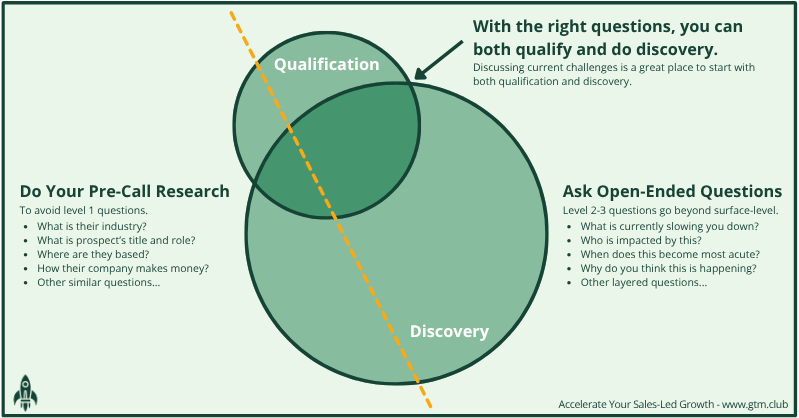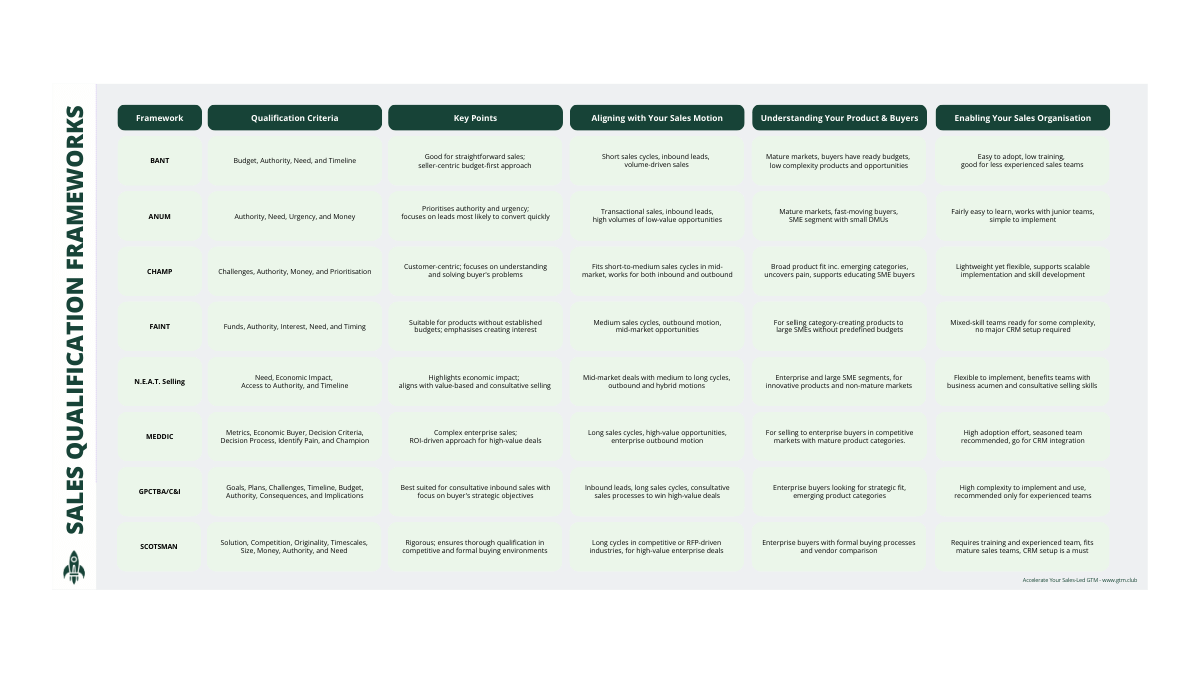Different Qualification Criteria and Discovery Themes in Tech Sales
Effective sales in the B2B tech sector rely heavily on two interconnected processes: qualification and discovery. Qualification involves assessing whether a potential customer is a good fit for your solution, while discovery delves deeper into understanding their business context and specific needs.

Understanding how qualification and discovery function in tech sales is fundamental to effectively closing deals. Qualification helps sellers to identify prospects who are not just the most promising and a good fit, but also those that they can actually win. Discovery, on the other hand, ensures sellers have a deep understanding of their prospects' situation and needs, so they can craft a winning proposal and address the pain points prospects are looking to solve.
While qualification and discovery have distinct objectives, they frequently overlap. Both activities involve independent research and interactive discussions with prospects. These complementary processes equip sales teams with crucial insights, enabling them to identify promising leads, tailor impactful solutions, and ultimately close more deals.

In this article, we go through:
- Start with the customer's pain and need
- Must-use qualification criteria
- Evergreen discovery themes to discuss
- More topics for qualification and discovery
- Additional reading and resources
Where Does It Hurt?
Understanding prospects' pain is the very foundation of qualification and discovery.
Before any meaningful sales conversation can begin, you must uncover where it hurts. You are looking for a pain your prospect or a customer is experiencing. Customer pain is an expression of problems, frustrations, inefficiencies, risks, or challenges that their company, individual department, or team faces. In practice, the pain is linked to business outcomes such as missed revenue, wasted resources, productivity bottlenecks, compliance risks, and operational headaches. In other words, a pain is the gap between the customer’s current state and their desired state.
A pain is the gap between the customer’s current state and their desired state.
Uncovering and focusing on customer pain makes your sales conversations relevant and impactful. It guides discovery questions, helps qualify opportunities, and ensures you demonstrate tangible business value. Without significant pain, there’s rarely a compelling reason for the customer to buy or change the way they work.
Depending on the framework, pain can also be referred to as Need (for example, N in the BANT and ANUM) and Challenges (CH in CHAMP and the first C in GPCTBA/C&I). While most descriptive term, Pain is used in fewer frameworks, such as MEDDIC and SPICED.
In the dialogue with prospects, look to identify specific problems, inefficiencies, or frustrations they face. Challenges can arise from internal issues, such as a lack of expertise, or from external factors, such as market changes. Verify that your solution addresses a real business problem.
- Identify specific pain points and challenges. Understand the impact of these challenges on their business.
- Quantify impacts such as costs, time, or productivity losses. Explore implications if challenges remain unaddressed.
- Evaluate how well your solution fits their needs. Make sure they have a pain you have a remedy for.
Example questions:
- "What are the biggest obstacles or pain points preventing you from executing your plan or hitting your goals?
- "What are your biggest operational bottlenecks?"
- "Can you help me understand the specific challenges your team is facing with [current process/solution]?

Like a doctor, you must listen to the prospect to locate the source of the pain. Only then you can start treating it.
Most Common Qualification Criteria
On top of pain, three other criteria - Decision-Makers, Financial Capability, and Timeline and Urgency - form the foundation of most, if not all, qualification frameworks in B2B sales.
You can use these recurring qualification criteria, albeit with different names and emphases, in frameworks such as BANT (Budget, Authority, Need, Timeline), CHAMP (Challenges, Authority, Money, Prioritisation), and ANUM (Authority, Need, Urgency, Money). While each framework might approach things somewhat differently, these four elements are consistently recognised as essential for successful qualification. Ensure you include pain and these three others in your qualification.
Ensure that you cover these four items in your qualification.
Decision-Makers
Understanding who has the power to make purchasing decisions is fundamental. Sales teams must identify and engage with the right stakeholders who can either decide on the purchase or, at a minimum, significantly influence the decision-making process.
- Confirm your primary contact is someone who can either make or strongly influence the purchasing decision.
- Identifying all key stakeholders involved.
- Determining who controls the budget.
Example qualifying question: "Can you walk me through your company's decision-making process for technology investments like this? Who are the key stakeholders we should involve in our discussions?"
Financial Capability
Evaluating financial capability is crucial. It helps you avoid wasting time on prospects who can't afford your solution or whose pain doesn't justify the investment. Discussing the budget ensures you're pursuing opportunities that can close.
- Confirm available budget allocation or willingness to locate new funding.
- Understand their budgeting process and cycles.
- Assess the financial impact of their current challenges.
Example qualifying question: "What is your current budget for this type of solution? What are the financial implications if this issue is not addressed?”
Timeline and Urgency
Understanding the prospect's timeline and sense of urgency helps to prioritise and align your sales process with their decision-making timeline. A clear timeline also indicates the prospect's commitment level and helps forecast deal closure accurately.
- Understand their implementation timeline.
- Assess the urgency of solving their challenges.
- Recognise potential timeline constraints or delays.
Example qualifying question: "How does this project align with your strategic goals for the year? What's driving your timeline for this project?"
Evergreen Discovery Themes
Effective discovery encompasses three essential themes to build a comprehensive understanding of your prospect’s situation, enabling the development of tailored solutions and more precise value propositions. Covering only needs and pains, as well as decision-makers, financial capabilities, and timeline, is not enough to form a comprehensive customer understanding. You want to learn where your prospect is coming from, where they are headed, and why they are on this journey. Discovery is a must.
These key themes consistently appear across various discovery methods and sales methodologies, including SPIN Selling and Solution Selling. While each method may emphasise different aspects or use unique terminology, these fundamental areas of inquiry remain essential for understanding the prospect's situation and qualifying opportunities effectively.
You want to learn where your prospect is coming from, where they are headed, and why they are on this journey. Discovery is a must.
Current Situation & Background
Understand existing processes, team structures, and the business environment. Capture detailed information about current technologies and necessary integration points. Remember that these questions often remain at the surface, so make sure to ask questions you haven't answered independently.
- Find out if there have been previous attempts to solve the same or similar problems.
- Clarify how current processes work today towards their goals.
- Capture detailed information about current technologies and necessary integration points.
Example discovery question: "What prompted your team to look for a new solution? What is your current workflow today, and which tools are central to it?"
Goals & Outcomes
Clearly defining what success looks like for your prospect allows you to position your solution precisely. This includes short-term goals that need immediate attention and long-term strategic objectives that align with the organisation's vision. Understanding both immediate and future goals helps tailor your solution's value proposition to turn your offering from a nice-to-have to a must-have.
- Understand specific, quantifiable objectives.
- Clarify strategic goals tied to broader organisational priorities.
- Identify the criteria used internally to evaluate success.
Example discovery questions: "Are there any quantifiable objectives (like increasing leads by X% or cutting costs by Y%) that you need to achieve? How does your team define success in addressing this issue?"
Impact & Consequences
Highlight the broader implications if current problems remain unresolved or the potential benefits if goals are met. These questions can add emotional weight to the conversation by connecting the project to results that matter to the prospect. While SPICED includes the Impact element, GPCTBA/C&I also has Consequences.
- Explore positive outcomes if goals are achieved.
- Highlight adverse outcomes or risks if challenges continue.
- Clarify personal stakes for key stakeholders.
Example questions: "What new opportunities could achieving these goals unlock? What might happen if these challenges continue unresolved for another 12 months?"
Common Topics in Both Qualification and Discovery
Some topics are discussed in both qualification and discovery. They are relevant across different frameworks and stages in the sales cycle. This is especially true with discovery, as there is no such thing as a fully completed discovery.
While the four core qualification criteria discussed above form a solid foundation for basic lead and opportunity validation, many sales organisations implement more comprehensive frameworks or sales methodologies, such as FAINT, N.E.A.T. Selling™, SPICED, MEDDIC, MEDDPICC, SCOTSMAN®, or GPCTBA/C&I (rolls off the tongue). These more comprehensive frameworks add additional qualification criteria and sometimes delve pretty deeply into discovery territory.
The decision to use more granular guidelines often depends on factors such as solution complexity, competitors, and the number of stakeholders involved in the purchasing decision. For example, MEDDIC's emphasis on metrics and economic buyers is crucial in specific enterprise sales processes, and SCOTSMAN's focus on solution fit is in others. While heavy, GPCTBA/C&I may be the most customer-centric of all these options, offering yet another choice for sales organisations. Furthermore, methodologies, such as SPIN Selling, Solution Selling, and Challenger Sale, introduce elements worth considering.
Here, we introduce additional discussion topics from these more comprehensive frameworks and sales methodologies. Depending on the framing, any of these topics can act as a qualifying factor or a discovery question.
Success Metrics
Buyers can more easily justify the investment when vendors can align their value proposition with specific KPIs and expected business outcomes. Understanding and quantifying the potential impact helps build a compelling business case. The G (Goals) in GPCTBA and M (Metrics) in MEDDIC are relevant here.
- Define key performance indicators.
- Establish expected outcomes.
- Align on measurement criteria.
Example questions: "How will you measure the success of this project? What specific metrics or KPIs are most important to your organisation?"
ROI & Financial Impact
Don't just qualify for budget availability; explore the financial justifications and the return on investment (ROI) they seek. Determine how the prospect will evaluate success after implementing your solution. By recognising the key metrics for buyers, you can position your product as one that delivers quantifiable ROI.
- Identify financial justifications required by stakeholders.
- Clarify the ROI metrics important to decision-makers.
- Understand budget flexibility for addressing identified challenges.
Example questions: "What would the financial impact be if you could successfully address these issues? Which financial metrics do you prioritise when evaluating new solutions?"
Decision-Making Process
Understanding the decision-making process is crucial for successful B2B sales. This involves mapping out all the steps, stakeholders, and requirements required to get from initial interest to a signed contract. For example, the P in MEDDPICC (as in Paper Process) reflect this factor. This goes deeper than just checking authority in the qualifying section.
- Map the complete approval process and workflow.
- Identify all stakeholders involved in decision-making.
- Understand legal and procurement requirements.
Example question: "Could you walk me through your typical approval process for a purchase of this size? Who must be involved at each stage, and what documentation is required?"
Competitive Landscape
Evaluating the competitive landscape helps you understand your position as a possible vendor and adapt your sales strategy accordingly. It also reveals potential obstacles and opportunities in the sales process that might not be immediately apparent. C for Competition is included in MEDDPICC and SCOTSMAN.
- Identify other solutions being evaluated.
- Understand your unique differentiators.
- Know their previous experiences with similar solutions.
Example qualifying question: "What other solutions are you currently evaluating? What made you interested in these particular options?"
Identify Champion
A champion within the prospect's organisation can significantly impact your success rate. A champion believes in your solution and actively advocates for it internally. They can provide valuable insights, help navigate internal politics, and keep the deal moving forward. Champion (C) is included in both MEDDIC and its more complex MEDDPICC version.
- Identify potential champions early in the sales process
- Build strong relationships with champions who understand your value proposition
- Equip champions with materials and information to advocate internally
Example question: "Who else in your organisation might benefit from this solution? Would you be comfortable introducing me to other stakeholders who could provide additional insights into your needs?"
Qualification and Discovery Resources from GTM Club
By systematically evaluating prospects against selected qualification criteria, sales teams can focus on the most promising opportunities. With thorough discovery, then, they can substantially increase their chances of winning those qualified opportunities. One needs both qualification and discovery to be successful in tech sales!
Here are some of the resources that can help you:
- Read more about qualification in tech sales
- Our guide to choosing a sales qualification framework
- Two questioning techniques to use in discovery
GTM Club’s Guide for Selecting a Qualification Framework is available as a free digital download for all our members.
Join now to download and receive all member benefits!
Note: This article was originally published on January 19, 2025, and has since been expanded to cover not only qualification criteria but also discovery topics.






